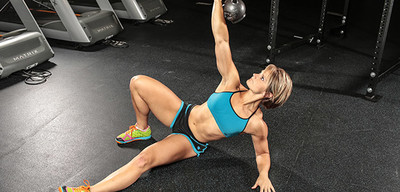Legend has it that when old-time strongmen were asked to take on an apprentice, they would show their applicant a single movement: the get-up, also known as a Turkish get-up. The teacher would tell his would-be apprentice to come back when the applicant was able to perform it with 100 pounds. Then the real training would begin.
Regardless of how literally you take this story, it clearly portrays the appeal of this complex movement. The get-up is a lift that teaches you how to lift—specifically, how to move with and under—heavy weight. It's a fantastic way to teach body awareness and body control, and if you followed the legend to the letter you'd end up a force to be reckoned with in pretty much any other strength pursuit.
Why is getting up off the ground with a weight in your hand so special? To pick just one reason, performing a heavy get-up correctly and safely requires you to "lock" your ribcage to your pelvis by way of your abs. This is a key skill for all types of athletes to master, as it allows them to both produce and absorb force through a diverse range of stances. The Turkish get-up is also the best shoulder strengthener around, bar none.
If you've been wondering why strength coaches, rehab specialists, and strong people around the world have been raving about this movement, consider this your apprenticeship.
The Get-Up There and Back Again
The get-up isn't a single movement. It's multiple motions woven together, incorporating all three movement planes more than once. Here it is broken down step-by-step, with details about how to move properly from each position to the next. Properly means safely. As we say in StrongFirst, safety is part of performance, not separate from it.
1. Cradle and Grip the Kettlebell
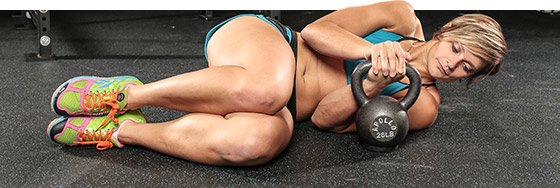
{{caption}}
- Place the kettlebell next to the shoulder on the side you're working.
- Roll to your side and cradle the kettlebell with both hands. The working hand grips the kettlebell, and the opposite hand covers it.
- Roll onto your back and place the kettlebell on your stomach.
2. Press the kettlebell overhead
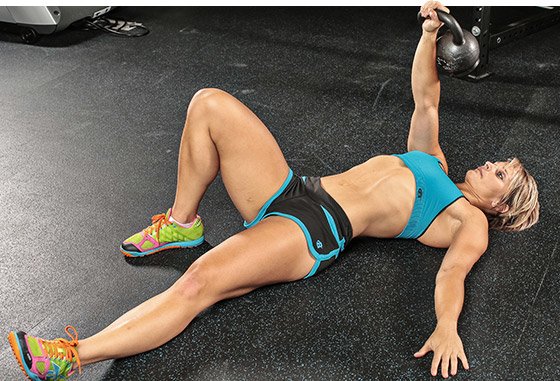
{{caption}}
- Move the bell so the arm is perpendicular to the floor, either using one hand or both. Some people choose to add a single-arm press, but it's extra credit and not the norm, especially once the weights get heavy. A two-handed pistol-grip press is just fine.
- Lock out the elbow, and pull the loaded shoulder into its socket.
- Bend the knee on the side of the body that's holding the kettlebell.
- Place the opposite arm on the floor approximately 45 degrees from the body.
3. Roll up onto the elbow, then the hand
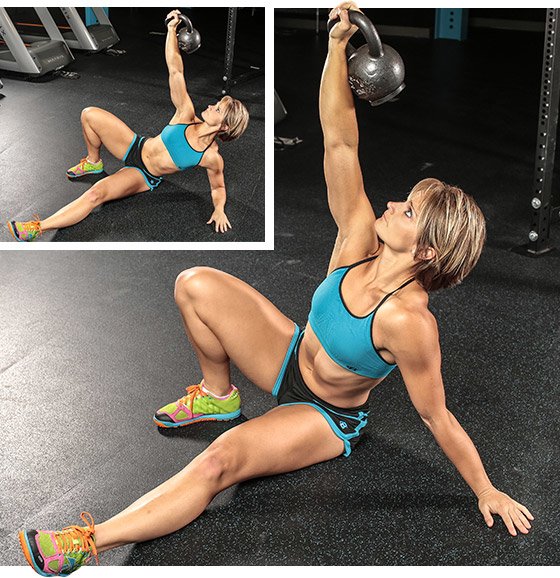
{{caption}}
- Take a deep breath and hold it.
- Drive from the foot on the working side, roll up onto your elbow, and exhale. Once you're stable at the elbow, roll up onto your hand. Don't skip step three and go straight to the hand!
4. Lift the hips
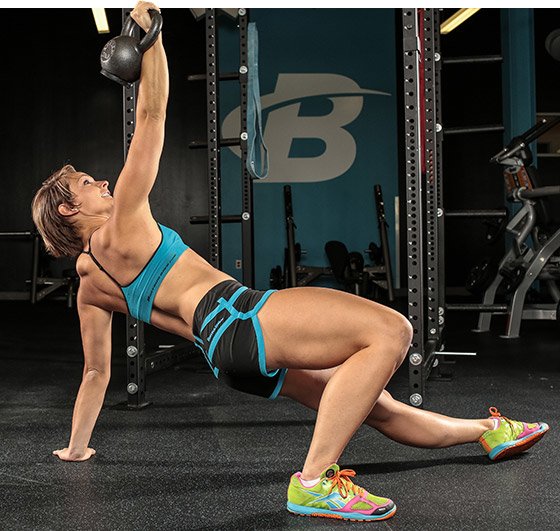
{{caption}}
- Squeeze your glutes and lift your hips off the ground high enough to be able to move your outstretched leg under your body. You'll support yourself on one arm, the heel of the straight leg, and the surface of your flat foot, like a tripod.
- Keep your arm extended totally vertically. When the weights get heavy, you'll know why.
5. Sweep the leg and find a lunge
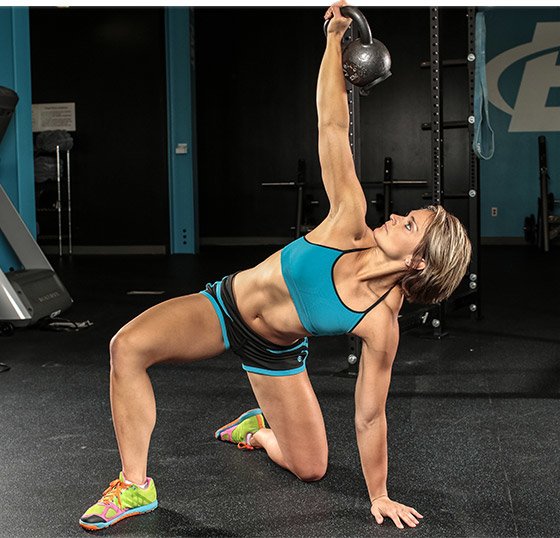
{{caption}}
- Take your straight leg and pull or sweep it under your body, placing it next to and behind the hand on the floor.
- You'll end up in a position that makes your legs appear to be 90 degrees from each other. One knee will be pointing straight ahead, and the other should point directly at the hand on the floor.
- Keep your neck rotated upward, looking up at the kettlebell in your hand.
6. Stand up from the lunge
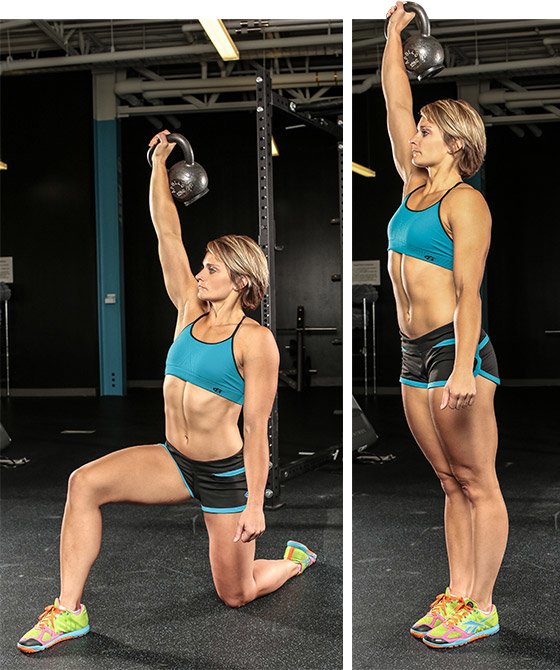
{{caption}}
- Take your support hand off the floor and move your body upright, keeping the kettlebell overhead. At this point, shift your gaze so you are looking straight ahead.
- "Windshield wiper" the leg that's on the ground so that both legs are now parallel to each other, in a lunge position.
- Drive from your back foot, through your hips, and into your front foot, standing up from the lunge. Keep looking forward!
7. Descend from the lunge
and get down
- While still looking forward, step back into the lunge so that your knee is on the floor.
- "Windshield wiper" the back leg to perpendicular from the front leg.
- Fold into your hips and place your hand just in front of the knee on the floor.
- Stick your leg straight out in front of you and put your butt on the floor.
- Roll down to your elbow, and then down onto your shoulders and back.
- Lower the kettlebell with two hands to your stomach, then roll to your side and place the weight on the floor.
Common Mistakes
There's a lot going on there, right? And, as you might believe, a lot can go awry before you've hit enough reps to have the basic steps memorized and ingrained in your muscle memory.
Once you're solid on the basics, the specific problems that hold most people back become more predictable. Here are the three most common mistakes I see that keep trainees from being able to progress from light Turkish get-ups to heavy ones.
Mistake 1 Failing To Grip The Kettlebell Properly
Unlike a dumbbell or barbell, the kettlebell is meant to be "over-gripped," or pulled into what feels like slight wrist flexion. This is necessary because of the offset center of mass of the kettlebell. It "hangs" below your wrist and on the back of your forearm, meaning it's trying to pull your wrist into hyperextension, which increases the likelihood of injury and loss of balance. Over-gripping brings the center of mass closer to the bones of your arm and makes for a stronger, safer position.
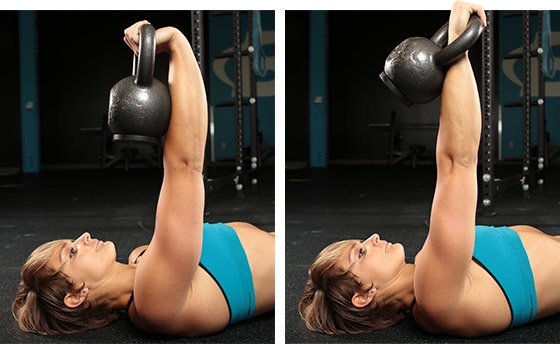
{{caption}}
Simply think about making a fist as if you were going to punch a heavy bag. Or, if you like, do 10 push-ups on your fists. You'll find the perfect position soon enough.
Mistake 2 Bending Your Elbow
Apart from a hyperextended wrist, this is the most common mistake I see on the get-up. And it's potentially the most harmful one.
Once you allow your elbow to bend even a little bit, you're holding the kettlebell with your musculature alone rather than taking advantage of your body's support structure. During a properly performed get-up, the weight is always well-supported by passive structures, i.e., your bones. This is why you're able to pause and take a breath in each of the positions: You're moving from one strong position to another.
When you bend your elbow, you destabilize the shoulder, increasing the chance of injury. Not only that, you become overly-reliant on your triceps. When your triceps fatigue—which can and does happen without warning—you might drop the bell and most likely get hurt in the process, particularly if you try to "save" the lift. If you find yourself in this position, don't try to save it. Just get out of the way and let the weight fall.
True story: While training a group of Marines, an instructor kept telling a number of them to lock their elbows. One failed to heed her advice. The Marine's triceps gave out, and the kettlebell fell on his face, breaking his jaw and knocking out a large number of his lower teeth. After he did his burpees for punishment, he was allowed to go see the medic.
So what's the fix? Well, it depends on whether your problem is technique or mechanics. To be blunt, it depends on whether you're lazy or just really tight.
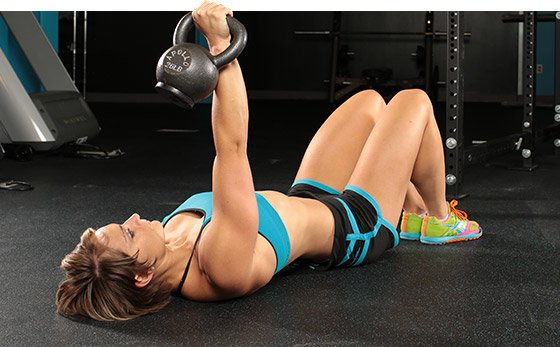
{{caption}}
Take advantage of your body's support structure. Keep your elbow straight.
So what's the fix? Well, it depends on whether your problem is technique or mechanics. To be blunt, it depends on whether you're lazy or just really tight.
Technique
If you can straighten your elbow but are just too lazy to do so, focus on pushing your fist up to the sky while simultaneously pulling your shoulder into its socket. Sometimes, achieving this is as simple as just gripping the kettlebell harder. The tighter you grip the kettlebell, the more you'll cause your other muscles to work, through the process of muscular irradiation. Your arm will automatically straighten out, and all the joints involved in the movement will get more stable.
Mechanics
If you're not being lazy, there's a good chance the problem could be functional, i.e., tight biceps from doing too many curls. If this is the case, stretch your biceps between sets and only practice the stages of the get-up where you can keep your elbow straight. If that means only rolling up to the elbow or hand, so be it. Partial get-ups are great movements in and of themselves.
Mistake 3 Letting Your Shoulders Go Soft
Soft shoulders are passively shrugged shoulders, where the head of the humerus isn't "packed" and centered in the shoulder socket. Get that humerus deep in the socket, and it will give you control of movement and protection of the shoulder joint and muscles. You need to maintain this sensation throughout the entire lift.
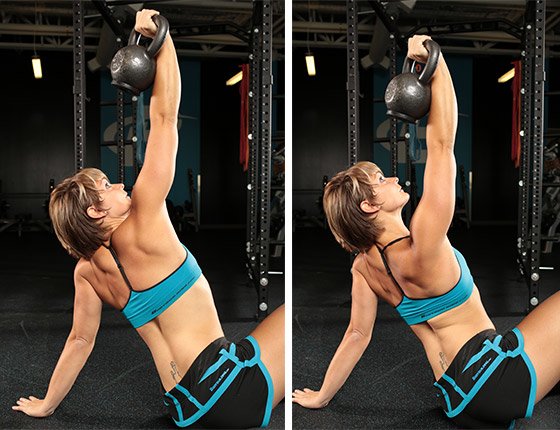
{{caption}}
A little-known fact is that your shoulders are connected to your hips—each shoulder to the opposite hip—through a series of fascial slings. If you shrug one or both shoulders, the loss of tension causes you to tighten up your hips. This inhibits your ability to activate your abs when you roll up, and decreases your ability to stand up powerfully in the lunge. Combined, these lapses put undue stress on vulnerable places like knees and the lumbar spine.
How do you fix your shrugging shoulders? Use what's known as the "anti-shrug." Instead of elevating your shoulders, think about pulling your shoulder blades into your back pockets. This engages your lats, which creates a "shelf" capable of supporting the kettlebell overhead and your weight on the floor.
If the anti-shrug doesn't help, then you'll have to address your tight muscles, specifically the ones that surround your shoulder girdle: your pecs, lats, triceps, and biceps.
Small Details, Big Difference
These three areas—the grip, elbow, and shoulder—may seem like minor players in a whole-body movement like a Turkish get-up, but I can tell you firsthand from teaching would-be kettlebell instructors over the last 8-plus years that these details make a profound difference, particularly once you've got a 53-pound kettlebell over your face. Small decisions and small joints can make the difference between feeling like a strongman's apprentice and having your jaw wired back together. Choose the right path and earn your stripes the old-fashioned way!

